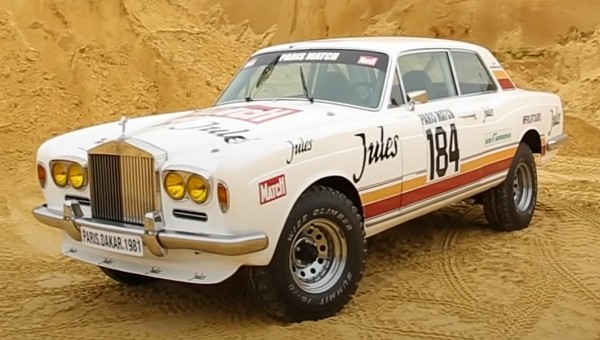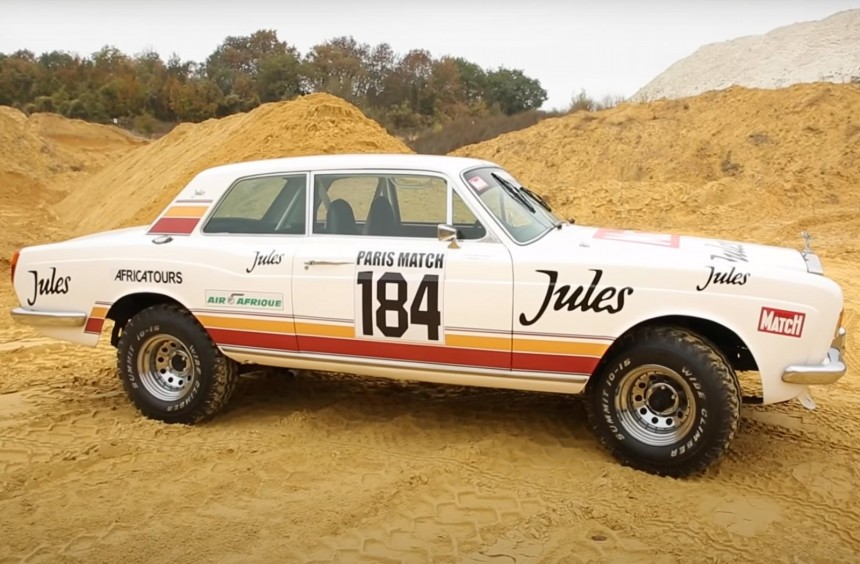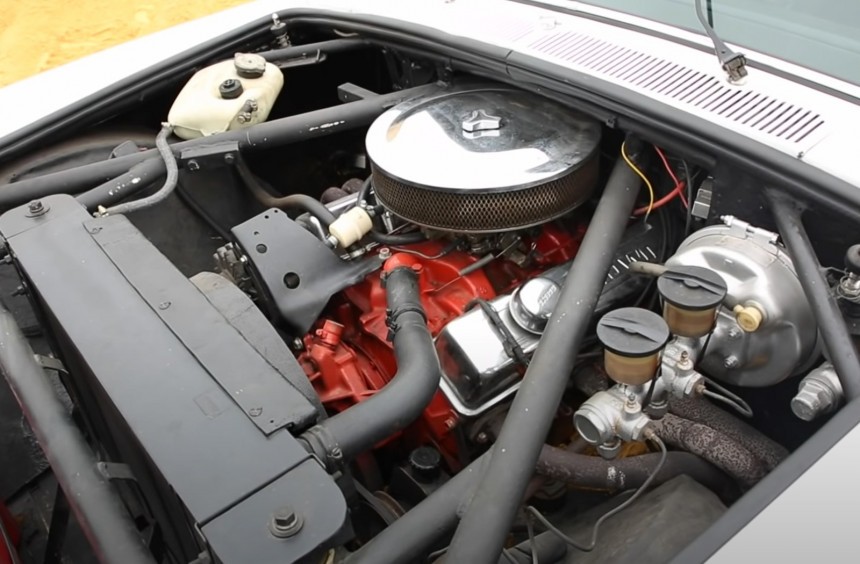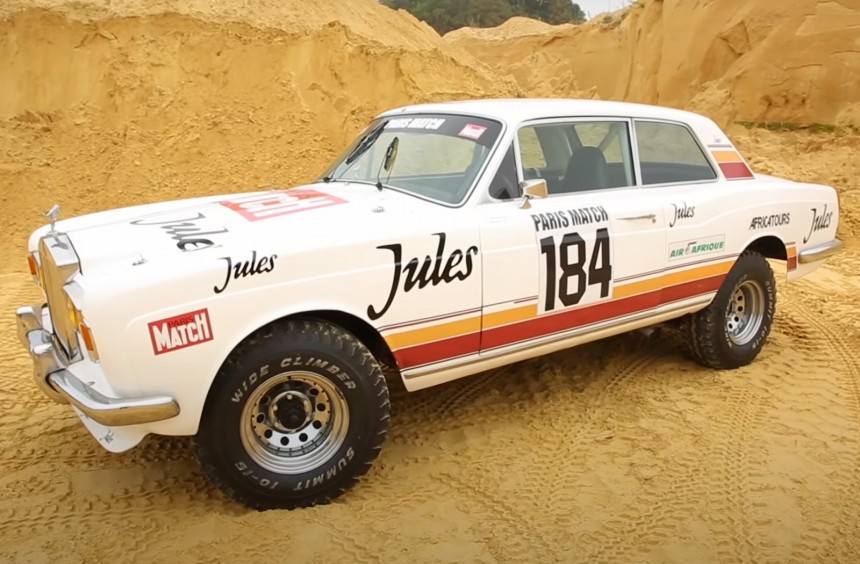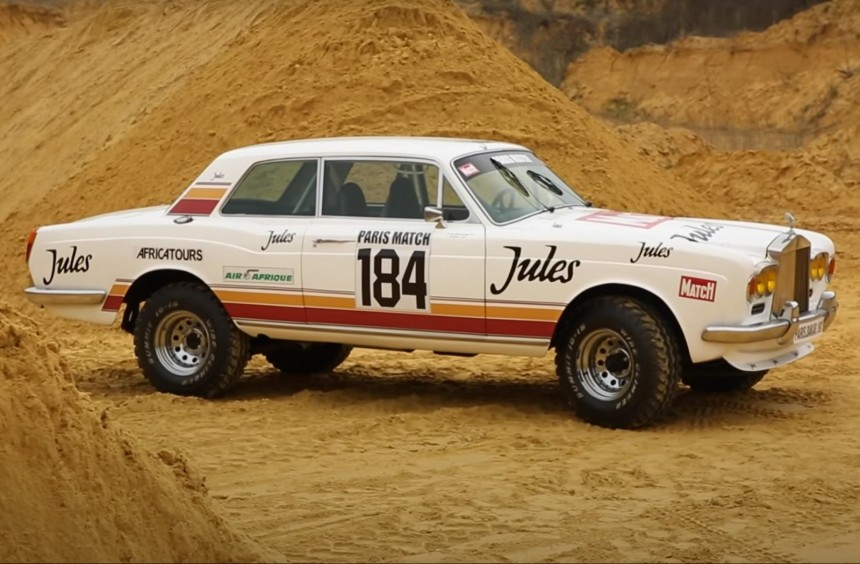A symbol of elegance and wealth, the luxurious Rolls-Royce Corniche is probably the last vehicle on Earth that someone would choose to go rallying with. However, 42 years ago, two eccentric Frenchmen thought it would be a great idea and ended up competing with one in the world’s most difficult rally raids.
Since the early days of motorized vehicles, both machines and humans have been regularly put to the test in organized endurance races. While some preferred to compete on paved roads or specifically-developed race tracks, others felt the need to make things more challenging and turned to off-road environments.
Finally, endurance racing organizers ended up combining on- with off-road courses, giving birth to some of the most exciting, yet difficult motorsport events, such as the Dakar rally.
Currently held in Saudi Arabia, the famed annual rally raid was initially staged from the French capital of Paris to the Senegalese capital, Dakar on a mammoth 10,000-kilometer (6,200 mi) course that included a huge chunk of the treacherous African desert.
In the first few editions, only privateers took part but by the early 1980s, the fame of the event attracted the interest of big-time manufacturers that began entering factory-built machines.
The list of brands that competed in the grueling rally raid throughout the years includes some surprising names, but Rolls-Royce is not one of them. The British luxury carmaker didn’t need a motorsport program to promote its models and it never build anything that was remotely compatible with the environment, so the last car you would expect to see in the African desert was a Rolls. However, one did compete in 1981, and it all started with a joke.
When two best friends with a passion for cars go out for some drinks and jokingly come up with the idea of competing in the Paris-Dakar rally with a Rolls-Royce coupe, you would expect them to forget all about it after a good night’s sleep. But, Thierry de Montcorgé and Jean-Christophe Pelletier didn’t forget about their insane idea the next morning and ended up turning it into reality.
The car in question was a first-generation Corniche owned by Jean-Christophe. While out for a glass of wine with his good friend Thierry, he felt the need to unburden his soul by talking about the car’s reoccurring mechanical issues. At some point, they concluded that rather than continuing to spend money on expensive repairs, Jean-Christophe should just trash it in style, by entering it in the renowned rally raid.
Although both friends were well-off financially, turning this insane idea into reality required some serious funds. Thus, the friends pulled some strings and arranged a meeting with some decision-makers from the Christian Dior fashion house and convinced them to sponsor their endeavor.
Donning “Jules” logos that promoted the company’s latest men's fragrance, Jean-Christophe’s Corniche was extensively modified for the competition in about 3 months. Its original chassis was stripped off and replaced with the ladder frame from a Toyota HJ45 Land Cruiser which was renowned for its sturdiness and happened to have a similar wheelbase. The Japanese off-roader also lent its four-wheel-drive system and transmission to the British coupe, while the power was delivered by a 350-ci (5.7-liter) Chevrolet crate engine imported from the U.S.
All that remained from the original car was its windows, bumpers, dashboard, and front grille - complete with the iconic Spirit of Ecstasy ornament. A custom steel frame was built around the Landcruiser chassis, with fiberglass panels cast after the original Rolls body to keep weight at bay. This theme continued inside where the lavish interior was gutted out and replaced with a couple of ordinary bucket seats taken from an Alpine sports car, albeit both were upholstered in leather to preserve a small trace of that Rolls-Royce luxury.
In the pursuit of saving weight and making the car as fast as possible, the two friends gave up on most creature comforts, including the air conditioning system. This must have been a tough decision considering the scorching hot temperatures they faced while navigating through the desert.
However, to cope with the punishing conditions, the two typical French gentlemen stocked up on champagne and gourmet dishes (including oysters) before they left their home country.
As racing would stop during the night to allow participants to rest, Thierry and Jean-Christophe’s kept their morals high by enjoying a taste of France’s finest gastronomic goodies. Although the stash only lasted a few nights, it helped them through the unforgiving experience with big smiles on their faces.
The third running of the rally started on January 1st, 1981, in Paris where close to 300 vehicles lined up for the start. After two French stages, the teams arrived in Africa where they had to cross four different countries, mostly through desert regions, before arriving in Senegal’s capital, Dakar.
With Thierry behind the wheel and Jean-Christophe handling co-pilot duties, the “Franken-Rolls”, which was the clear fan favorite, proved to be surprisingly competitive. Halfway through the rally, it stood in 13th place, but a crash that damaged the steering system almost put an end to the adventure.
While the Frenchmen went ahead and fixed the car, it was considered an “illegal repair” by race officials who banned the tram from scoring points but allowed them to finish the rally.
In the end, the Rolls-Royce Corniche, which received the nickname Jules after its main sponsor, was one of only 170 vehicles to arrive in the Senegalese capital unassisted. It went down in Dakar history as one of the craziest vehicles to ever finish the rally and worked wonders for Dior’s marketing department, as the feat racked up millions of francs worth of advertising from countless features in TV shows and news articles.
Four years ago, Auto Moto magazine tested the car which was kept in pristine shape by its owners. Although the video review that you can watch below doesn’t feature subtitles, so you won’t be able to understand much unless you’re fluent in French, you can see the legendary car plowing through sand and hear its American V8 grumble.
Finally, endurance racing organizers ended up combining on- with off-road courses, giving birth to some of the most exciting, yet difficult motorsport events, such as the Dakar rally.
Currently held in Saudi Arabia, the famed annual rally raid was initially staged from the French capital of Paris to the Senegalese capital, Dakar on a mammoth 10,000-kilometer (6,200 mi) course that included a huge chunk of the treacherous African desert.
In the first few editions, only privateers took part but by the early 1980s, the fame of the event attracted the interest of big-time manufacturers that began entering factory-built machines.
How it all started
When two best friends with a passion for cars go out for some drinks and jokingly come up with the idea of competing in the Paris-Dakar rally with a Rolls-Royce coupe, you would expect them to forget all about it after a good night’s sleep. But, Thierry de Montcorgé and Jean-Christophe Pelletier didn’t forget about their insane idea the next morning and ended up turning it into reality.
The car in question was a first-generation Corniche owned by Jean-Christophe. While out for a glass of wine with his good friend Thierry, he felt the need to unburden his soul by talking about the car’s reoccurring mechanical issues. At some point, they concluded that rather than continuing to spend money on expensive repairs, Jean-Christophe should just trash it in style, by entering it in the renowned rally raid.
An English body, a Japanese chassis, and an American V8
Donning “Jules” logos that promoted the company’s latest men's fragrance, Jean-Christophe’s Corniche was extensively modified for the competition in about 3 months. Its original chassis was stripped off and replaced with the ladder frame from a Toyota HJ45 Land Cruiser which was renowned for its sturdiness and happened to have a similar wheelbase. The Japanese off-roader also lent its four-wheel-drive system and transmission to the British coupe, while the power was delivered by a 350-ci (5.7-liter) Chevrolet crate engine imported from the U.S.
All that remained from the original car was its windows, bumpers, dashboard, and front grille - complete with the iconic Spirit of Ecstasy ornament. A custom steel frame was built around the Landcruiser chassis, with fiberglass panels cast after the original Rolls body to keep weight at bay. This theme continued inside where the lavish interior was gutted out and replaced with a couple of ordinary bucket seats taken from an Alpine sports car, albeit both were upholstered in leather to preserve a small trace of that Rolls-Royce luxury.
Equipped with a stash of gourmet dishes and champagne
However, to cope with the punishing conditions, the two typical French gentlemen stocked up on champagne and gourmet dishes (including oysters) before they left their home country.
As racing would stop during the night to allow participants to rest, Thierry and Jean-Christophe’s kept their morals high by enjoying a taste of France’s finest gastronomic goodies. Although the stash only lasted a few nights, it helped them through the unforgiving experience with big smiles on their faces.
Proving surprisingly competitive and finishing the rally
With Thierry behind the wheel and Jean-Christophe handling co-pilot duties, the “Franken-Rolls”, which was the clear fan favorite, proved to be surprisingly competitive. Halfway through the rally, it stood in 13th place, but a crash that damaged the steering system almost put an end to the adventure.
While the Frenchmen went ahead and fixed the car, it was considered an “illegal repair” by race officials who banned the tram from scoring points but allowed them to finish the rally.
In the end, the Rolls-Royce Corniche, which received the nickname Jules after its main sponsor, was one of only 170 vehicles to arrive in the Senegalese capital unassisted. It went down in Dakar history as one of the craziest vehicles to ever finish the rally and worked wonders for Dior’s marketing department, as the feat racked up millions of francs worth of advertising from countless features in TV shows and news articles.
Four years ago, Auto Moto magazine tested the car which was kept in pristine shape by its owners. Although the video review that you can watch below doesn’t feature subtitles, so you won’t be able to understand much unless you’re fluent in French, you can see the legendary car plowing through sand and hear its American V8 grumble.
